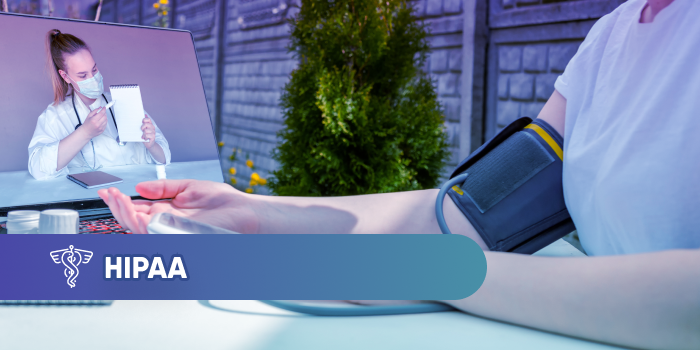How To Be HIPAA-Compliant When Using Mobile Devices
To be HIPAA-compliant when using mobile devices, healthcare professionals need to set up communication protocols that safeguard patient health...
5 min read
Paul Dumayac : 3/28/22 7:00 AM

Healthcare providers implement patient engagement activities to keep up with the high demand for patient-centric care models that promote high-quality care, increase patient satisfaction, optimize resources, and increase profits for medical practices. Staying HIPAA compliant is a challenge that they must overcome to achieve this.
Communicating with patients is critical to successful healthcare delivery, and keeping them engaged is rather challenging. Patient engagement activities aim for patient retention and healthcare continuity. These undertakings, however, put specific data at serious risk in the course of the communication process where a patient's protected health information (PHI) goes back and forth between provider and patient and, in select cases, to different providers, too. So, staying HIPAA compliant while engaging patients requires the utmost attention and diligence from healthcare professionals (HCPs).
Keeping your patients engaged in your medical practice, in essence, is keeping them loyal. Strong patronage of your medical services and professional advice means you have patients who follow your prescribed treatment plan and are willing to continue their care management partnership with you.
Patient loyalty, as the byproduct of quality healthcare and patient satisfaction, is an essential factor in driving the success of your medical practice. Moreover, it promotes continuity of care, improves patient outcomes, and positively impacts the healthcare industry.
It may not be entirely appropriate to make an analogy of patients as consumers, but it is worth noting that, in business marketing models, it is five times more expensive to acquire a new customer than to nurture an existing customer.
The case may be different with the healthcare system, but being a financially constrained and resource-challenged industry, engaging patients and keeping them loyal offer benefits such as lowering your operational cost and improving patient retention. It is your best, if not the only, move to thrive and succeed in your practice.
Patient engagement is a patient-centric approach to encouraging patients to actively participate in their healthcare management to improve outcomes and lower costs.
Engaging patients, then, includes implementing activities that establish the necessary connection to develop that patient-provider relationship into a collaborative partnership for as long as you can.
These activities include efforts to reach out to patients with the following purpose or value:
Strategies for communicating and engaging with patients may vary from one practice to another and require the use of technology to be effective, such as 2-way text messaging, chat reminders, email, or automated messaging. Telemedicine, for example, uses these communication channels to connect with patients.
It is imperative, though, to consider how patients want you to communicate with them for this to work. Patient preference, after all, is your model approach.
For instance, patients may find it difficult or discouraging to inquire about their illnesses or treatments over the phone. For one, getting through a busy phone line is already taxing to patients, and being put on hold for too long only to receive a promise you will call them back is another inconvenience.
From the internal office standpoint, clinic staff finds it challenging to keep phone lines open and attend to calls all day. And when they chance upon a patient call asking for an update, they might not know the answer yet to that particular inquiry at that moment — or have time to check because the office is busy.
Phone calls and their volume every day take a toll on both patients and providers.
Fortunately, 2-way texting solutions help you handle your patients' inquiries efficiently in ways that make it easier for them to ask questions any time of the day. It also allows you to respond to all of them almost instantly or save these inquiries and exchanges to get back to them in the future.
Patients want more convenient ways to communicate with healthcare providers. That's why patients prefer texting, and it is the most selected feature in telemedicine.
According to a survey, more patients (19.6%) prefer texting (SMS messaging) to patient portals (only 10%) when an in-person physician appointment or phone call is not possible, and people read 90% of SMS messages within three minutes of receiving them.
Texting offers advantages to both your patients and your practice. It is convenient for patients to send text messages to your office and wait for a reply from your staff rather than spend more time on phone calls. Front office staff receive less volume of calls when you implement text messaging options for patients. It is one of the conveniences medical practices desire to have in their offices.
Patients also find texting more helpful when it allows them to book appointments and chat with their doctors as a form of telemedicine care. And they are happy with how texting enables them to reschedule or cancel appointments conveniently. Consequently, this convenience to patients also results in a dramatic decrease in no-shows.
The demand for text messaging solutions is high. However, implementing such a telemedicine feature in medical practices is a process, and while it may seem like a struggle, Curogram has an easy solution. Before we cover implementing HIPAA-compliant text messaging and other telemedicine features, let’s review why it is important to engage patients.
HIPAA compliance is the main issue with text messaging in a healthcare setting. The Health Insurance Portability and Accountability Act (HIPAA) is a federal law that provides mechanisms and safeguards on how healthcare providers must handle patient information. The law also provides penalties or criminal charges to parties violating any stipulated rules and regulations.
HIPAA violation complaints go to the US Department of Health and Human Services (HHS), where it submits any available data to state attorneys to prosecute violators. Using non-compliant platforms to transmit a patient's PHI leads to fines and criminal charges for HCPs.
The severity of the punishment depends on certain factors, including HCP's awareness of the violation, the number of patients the data breach affects, and the time of the error's resolution. Fines for such violations also vary depending on the extent of the breach. For example, an HCP would have to pay anywhere between $100 and $1.5 million in a single case.
HIPAA's spirit as a law revolves around the principal goal of securing the patient's PHI from being abused, given its vulnerability in cyberspace.
HCPs must therefore keep identifying patient information safe and inaccessible to unauthorized third parties — a patient's PHI is a valuable piece of information that rests in the hands of HCPs. The information includes the following:
It's hard to be in a situation where you need to engage your patients as often as their condition requires and permits to improve healthcare service and patient satisfaction. Yet, you face penalties and criminal charges if you go about it the wrong way per the law.
It is more manageable, though, when you have grasped what and what not to do to stay HIPAA compliant while engaging your patients:
Your practice should have telemedicine software that encrypts, end to end, all exchanges between your patients and other providers. It ensures your patient engagement activities are HIPAA- compliant.
Before hitting that send button, make sure your patient consents to receive and send messages that may include PHI through either text messaging or email communications. You also need to get their permission before engaging in video conferencing.
Communicating and engaging patients don't always require exchanges of private patient information.
Not all your team needs access to every bit of information you may want to share with patients and colleagues.
Verify the receiver’s identity before sending out test results or other patient information when communicating through text or email. You can implement layers of verification methods to ensure you're exchanging data with the right patient or party.
There is no doubt that your practice needs to engage patients as they gain increasing interest in taking control of their healthcare and using telemedicine.
However, you must avoid data breaches and security failures when transmitting patients' PHI during patient engagement activities.
There is only one way to guarantee that your practice is HIPAA-compliant while engaging your patients: upgrading your practice management system to integrate secure text messaging and other communication protocols. It’s the more straightforward way of engaging patients and safe, too.

To be HIPAA-compliant when using mobile devices, healthcare professionals need to set up communication protocols that safeguard patient health...

In a demanding and competitive industry, businesses like your medical practice must consistently balance tasks to improve patient satisfaction while...

Text messaging (SMS) is one of the most sought-after telemedicine features. It simplifies the appointment making process, both virtually and in...